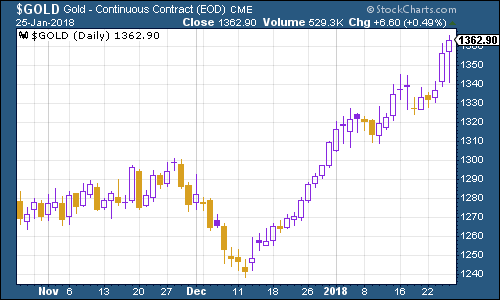
Welcome to your weekend edition, where we take a look through the charts that matter and catch up on anything else that we missed during the week.
If you missed any of this week’s Money Mornings, here are the links you need.
Monday: How passive funds could save shareholder capitalism
Tuesday: Now that the bond bull market is over, what comes next?
Wednesday: The new bull market in sterling is just beginning
Thursday: Is this a turning point in gold’s fortunes?
Friday: Here’s why the US dollar is weak – it’s a sign of a global bull market
This week’s podcast will be out on Monday (we’re experimenting with some tweaks to the format). If you haven’t already tried the podcast, you can hear last week’s here.
Let’s go straight to the charts this week.
Gold has advanced Is this a turning point in gold’s fortunes? as the US dollar has tanked. Careless words from the Here’s why the US dollar is weak – it’s a sign of a global bull marketbut more generally concerns about inflation are nudging higher up the agenda and that tends to be good for gold.
(Gold: three months)
The US dollar index – a measure of the strength of the dollar against a basket of the currencies of its major trading partners – fell sharply. It’s now near its lowest level since 2014. European Central Bank boss Mario Draghi’s apparent insouciance about the strengthening euro didn’t help.
(DXY: three months)
The yield on the ten-year US Treasury bond is still hovering around the 2.63% mark. That means it’s hanging onto the “bear market” territory line in the sand cited by various bond market “gurus”. I looked at what might come next in Now that the bond bull market is over, what comes next?.
(Ten-year US Treasury: three months)
How about the ten-year German Bund? This – the borrowing cost of Germany’s government – essentially represents Europe’s “risk-free” rate. As you can see, the large “spread” – or gap – between this and the US rate is starting to close up ever so slightly as the German yield rises and the US yield remains broadly static.
(Ten-year bund yield: three months)
Copper had a bit of a slump, then bounced this week. That’s partly about the gyrations in the dollar as much as anything else.
(Copper: three months)
Bitcoin is still hanging in there. It’s had a rough year so far, but equally it’s hard to write its epitaph at the moment. I won’t be buying in, but as Merryn points out in her letter in MoneyWeek magazine this week, the underlying technology is (and I know it’s a cliché to say this now, but it’s true) quite likely to be both important and useful in the future. But whether the tokens themselves – the bitcoins – will retain their value is another question.
(Bitcoin: ten days)
As for US employment – the indicator we like to keep an eye on is the four-week moving average of weekly US jobless claims, which fell back to 240,000 this week, while weekly claims came in at 233,000.
According to David Rosenberg of Gluskin Sheff, when US jobless claims hit a “cyclical trough” (as measured by the four-week moving average), a stockmarket peak is not far behind (on average 14 weeks), a recession follows about a year later.
But as the chart below shows, the most recent cyclical trough was in November, at 231,250. So we could still be some way from the peak. And if they stay at current levels then we may hit a new low before too long.
(Four-week moving average of US jobless claims: since start of 2016)
The oil price (as measured by Brent crude, the international/European benchmark) was back above $70 a barrel again, which was – as with every other commodity – partly assisted by the weak dollar. The main thing for the oil bulls to keep an eye out for now is supply revving up. At these levels, it becomes ever more tempting to get pumping more aggressively.
(Brent crude oil: three months)
Internet giant Amazon continues to look like the ultimate “melt-up” stock. Once upon a time, no one ever got fired for choosing IBM. Nowadays, no fund manager will get fired for owning Amazon. That – Jeremy Grantham of GMO might argue – is one reason why they’re all so keen to own it now, because on the one hand they’re terrified of a crash, but on the other they don’t want to miss out on the gains between now and then.
That makes Amazon the perfect stock for a manager living in fear of their career during a melt-up – because if and when the crash comes, no one’s going to tell you you were a fool to be holding a worldbeater stock like Amazon.
(Amazon: three months)
Tesla dipped a little this week on rumours that there are further problems with the construction of its Model 3 mass market car. CNBC reported that employees reckon that there will be further delays – and that quality control is slipping.
Yet Tesla has slipped up on many deadlines in the past. And it’s not clear what will make the bulls change their mind this time around. I imagine Tesla is just a bull market stock, and it won’t collapse until the bull market does.
(Tesla: three months)